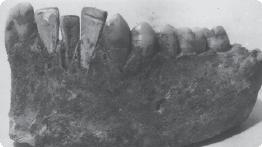3D printing in medicine: dental implants
 “Implants are the same flowers that are rooted in the ground. So they are fixed with a titanium root in the jawbone. Like a flower, the abutment grows out of the implant body and is dismissed by a crown in the dentition ”(c) Dr. Ronald Goldstein.
“Implants are the same flowers that are rooted in the ground. So they are fixed with a titanium root in the jawbone. Like a flower, the abutment grows out of the implant body and is dismissed by a crown in the dentition ”(c) Dr. Ronald Goldstein. The presence of teeth is difficult to overestimate: they help us eat, talk and make a smile socially acceptable. Teeth grind, stare, show, put on the shelf and hold their tongue. It is even more offensive when, due to age, due to increased sweetness or direct impact to the jaw, they are deprived. This is where dental implantology comes to the rescue: a science dating back about one and a half thousand years.
 Exactly: the earliest known implants were found in Honduras, and are dated to 600 AD. er Shells were used as false teeth, and, despite the location of the find, the operation was considered successful.
Exactly: the earliest known implants were found in Honduras, and are dated to 600 AD. er Shells were used as false teeth, and, despite the location of the find, the operation was considered successful.The modern stage in the history of dental implantology began, as is often the case, with a random discovery. In 1952, the Swedish professor Per-Ingvar Brånemark during one of the experiments could not pick out titanium fragments from the rabbit thigh. Titan practically merged with the bone. The phenomenon was called osseointegration, and already in 1981, the commercial “Branemark Implant System” announced itself. Now the dental implant market is estimated at $ 3 billion, and analysts estimate it to reach 4.5 billion in 2012.
How about this happens:

However, not everything is as simple as it seems. Depending on the complexity of the operation, new teeth can be obtained in a period from one hour to 4 months. The cost varies from one to several tens of thousands of dollars. Worse, hard cases are not only long and expensive, but also quite dangerous:
- It is not always possible to adequately estimate the thickness and density of the bone at the implant site using an ordinary X-ray. In case of an error, he will fall out on the first apple.
- There is a risk to touch the mandibular nerve with a drill or implant, which will lead to the loss of such important abilities as chewing and talking, and always open mouth will temper your attractiveness in the eyes of the opposite sex.
- At times, a successful operation is only 2 millimeters separated from a complete failure between the desired location and the depth of the drilled hole and what happened. Not every surgeon can boast an eye of similar accuracy.
This is where SimPlant comes to the rescue - the flagship product of Materialize Dental and the market leader in preoperative dental implant planning. Consider it in more detail.
')

So, first the patient is sent to a CT scan, from where he brings a pack of high-resolution images. Pictures are imported into SimPlant as a data cube, after which segmentation is performed (selection of anatomical structures) and nerves are drawn (we remember why this is important). Segmentation is usually performed by an employee of Materialize or one of the centers certified by the company.
The next step is planning the operation. The doctor can try on an implant, choose a model with the necessary parameters (the catalog contains almost all global brands and is regularly updated), assess the density of the supporting bone and the proximity of the nerve, implant a virtual tooth and admire the final result. It is even possible to schedule the operation fully automatically, taking into account all measurements and characteristics.
The completed plan is sent to Materialize, where it is once again checked by the company's specialists, and surgical guides (SurgiGuide) are calculated and printed on 3D printers already known to you - our jaws for the jaw of the patient, which fix the location, direction and depth of drilling.
With such preparation, the operation itself is a trifling matter. I, a software engineer by training, somehow managed to satisfactorily implant a tooth into the layout of everything from the second attempt.
By the way, this business model allows you not to worry too much about pirated copies of the program. SimPlant without printing surgical guides and support from the company's specialists is nothing more than a toy.
Preoperative surgery planning is a fairly new phenomenon, and Materialize continuously conducts clinical research, participates in the development of scanning and diagnostic devices, improves analysis algorithms and 3D printing technology. SimPlant (like many other products of the company) is certified by the FDA in the category of "medical equipment" and is the industry standard for quality. Well, we wish you to brush your teeth regularly and as little as possible to test our products for yourself.
Source: https://habr.com/ru/post/91680/
All Articles